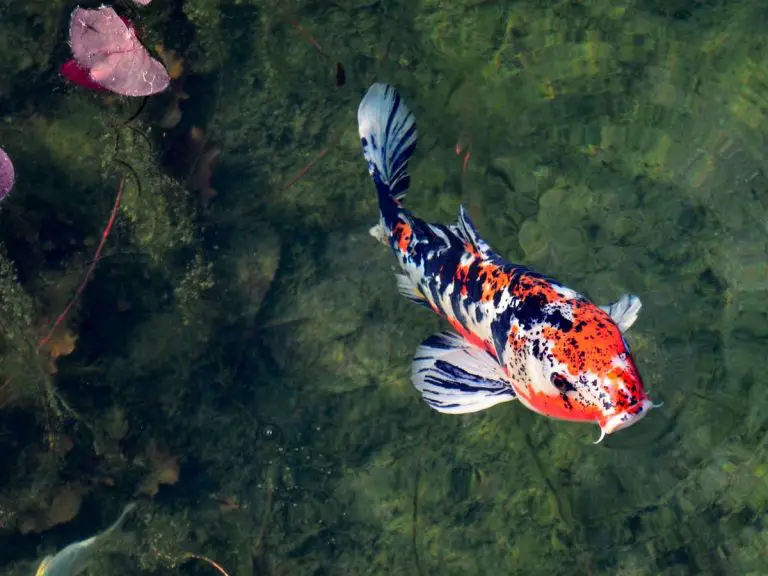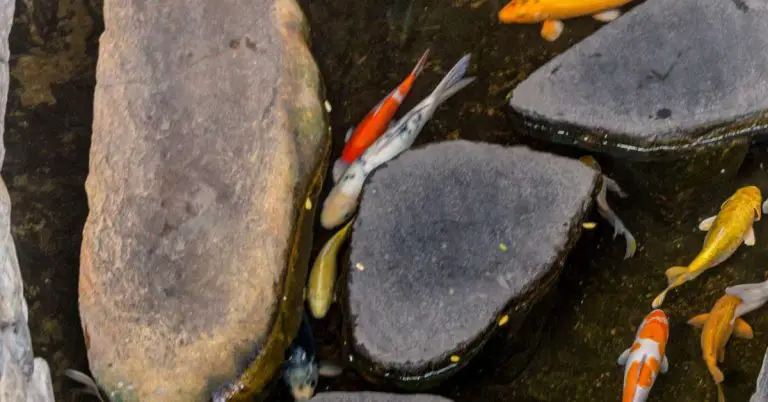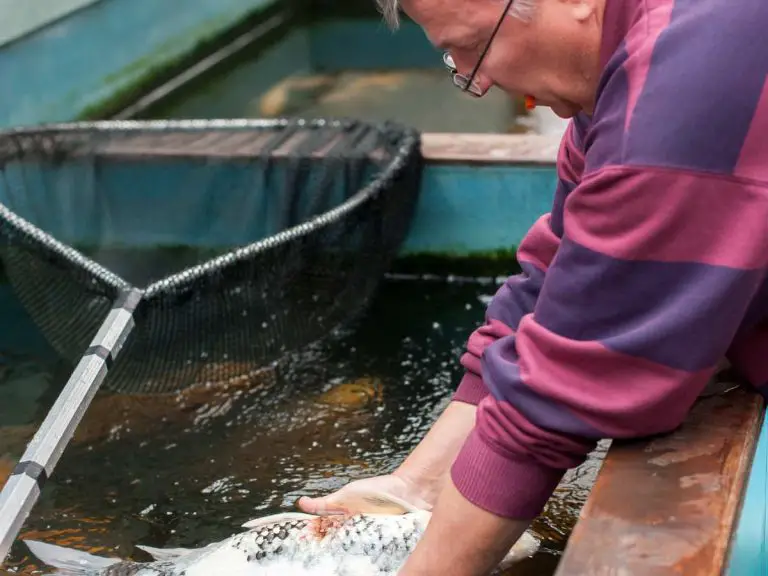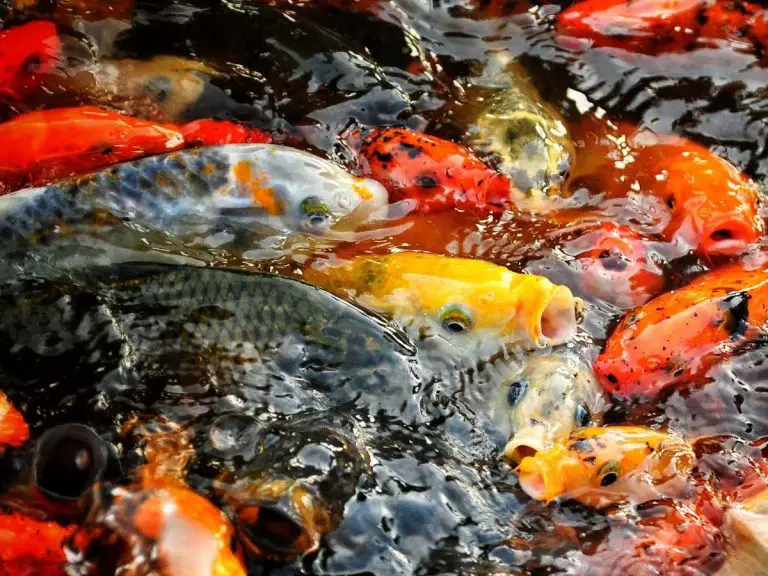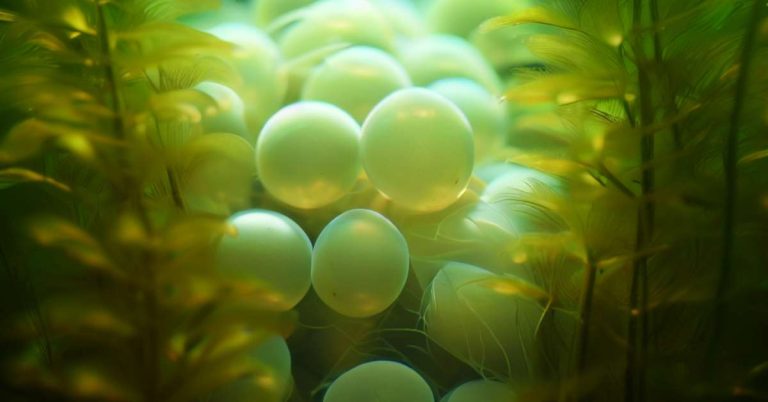Do Koi Eat Other Fish? Find Out How to Safely Keep Koi with Different Species
Do koi eat other fish? It’s a really important question when you’re thinking about adding these beautiful creatures to your backyard ponds or aquarium.
Yes, koi can and do indeed eat other fish. Koi fish are omnivores, and they have a wide-ranging diet that includes both plants and animals. So while they may not intentionally seek out other fish as their primary food source, smaller fish can often become a tasty snack for hungry koi.
But don’t worry, there are ways to ensure the safety of your smaller fish if you decide to introduce koi to your aquatic community. By understanding koi fish behavior and taking some preventive measures, you can create a harmonious environment where all your fish can thrive.
So let’s dive deeper into the feeding habits of koi fish and explore the strategies you can use to protect your smaller fish from becoming koi snacks. Trust me, it’s easier than you might think!

Koi fish feeding behavior: Are koi carnivorous?
First things first. Koi absolutely eat meat and other fish.
‘Carnivorous’ means that an animal eat meat exclusively, though. And that’s not the case with koi, who eat a wide variety of foods, not just meat.
Indeed, when it comes to their diet, koi fish are quite versatile, eating both plants and animals. This flexibility in their diet is one of the reasons why koi are so popular among pond enthusiasts.
In the wild, koi fish primarily feed on algae, insects, crustaceans, plants, and small fish and organisms. They have a keen sense of sight and can detect movement in the water, allowing them to spot their prey easily. Koi are known to be opportunistic feeders, meaning they will eat whatever they come across, including other fish.
In a pond setting, they are usually fed a diet of specially formulated koi pellets, along with occasional treats like fruits, vegetables, and even small crustaceans. Some people even make homemade food for their koi.
Factors influencing koi predatory behavior
Several factors can influence koi fish’s predatory behavior towards other fish. One significant factor is their size. Larger koi have a greater chance of preying on smaller fish, as they have a wider mouth and more substantial appetite.
Additionally, aggressive or territorial koi may target other fish, especially during the breeding season.
Will big koi eat smaller koi?
While koi are not typically aggressive predators, there are instances where larger koi might prey on much smaller fish, especially if the size difference is significant and the pond environment is stressful or if food is scarce. It’s not common behavior, but it can happen, particularly in overcrowded conditions or when the fish are under stress.
That said, it’s more common for koi to accidentally harm smaller fish while competing for food or during spawning season when they can become more aggressive. It’s always a good idea to monitor the behavior of koi in a mixed-size pond and ensure that all fish have ample space and resources.
Do koi eat goldfish?
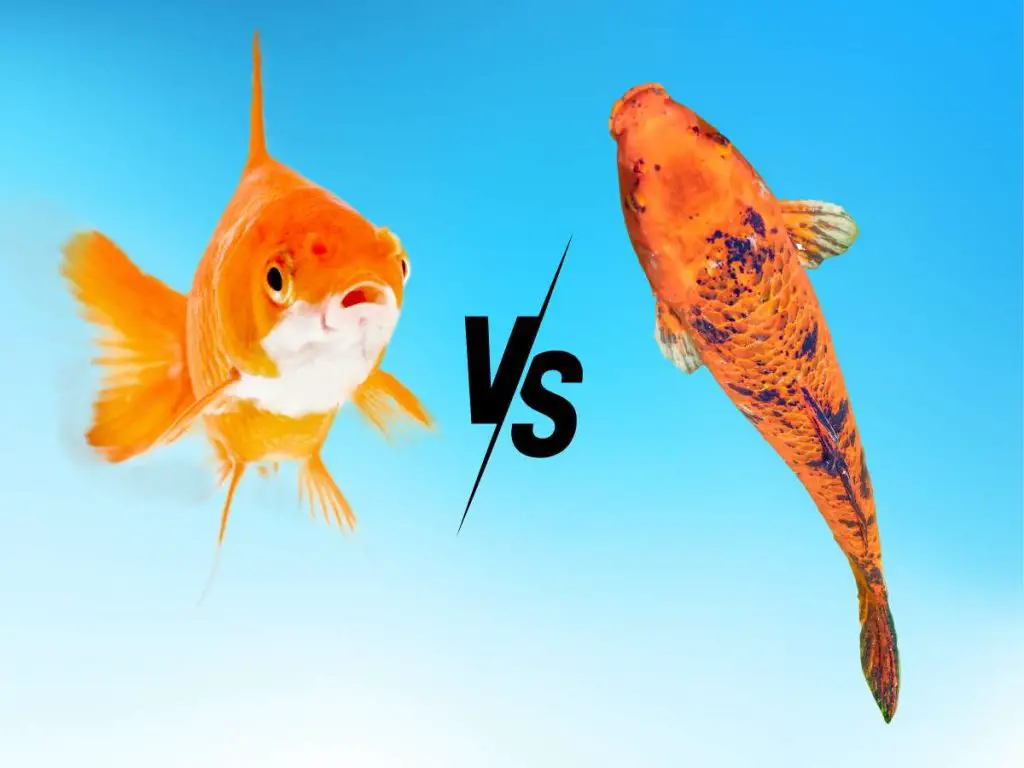
Yes, koi can eat goldfish, especially if there’s a significant size difference between them. Remember, koi are opportunistic feeders, and if a smaller fish, like a goldfish, fits into a koi’s mouth, there’s a possibility the koi might try to eat it. This is particularly true for juvenile goldfish or smaller goldfish varieties.
However, in many pond settings where koi and goldfish coexist, they often live together peacefully, especially if they’ve grown up together and there’s no significant size disparity. It’s also less likely for mature goldfish to be preyed upon by koi if they are of similar size.
If you’re considering adding goldfish to a pond with koi, it’s essential to monitor their interactions and ensure that the goldfish are not too small compared to the koi. Providing plenty of hiding spots and ensuring both species are well-fed can also reduce the risk of predation.
Factors to consider when keeping koi with other fish
Koi fish are a popular choice for pond owners due to their vibrant colors and peaceful demeanor. However, if you are considering keeping koi with other fish, there are several factors to consider to ensure a harmonious coexistence.
Size Compatibility
One important factor to consider when keeping koi with other fish is the size compatibility. Koi are known to grow quite large, sometimes reaching lengths of three feet or more. Therefore, it is crucial to choose fish species that can tolerate the size difference without becoming stressed or preyed upon. Opt for fish that are similar in size or have the ability to grow alongside koi without being overshadowed.
Aggression Levels
Another crucial factor to consider is the aggression levels of different fish species. Koi are generally peaceful fish, but certain individuals can exhibit territorial and aggressive behavior, especially during breeding season. It is essential to select fish species that can tolerate or match the aggression levels of koi to avoid constant conflict or injuries.
Food Competition
Food competition is another consideration when keeping koi with other fish. Koi are voracious eaters and can consume a substantial amount of food. Therefore, it is important to choose fish species that have similar feeding habits and dietary requirements. This will prevent the koi from dominating the food source and potentially starving or outcompeting the other fish.
Space Requirements
Lastly, it is vital to consider the space requirements of the fish species when keeping them with koi. Koi fish require ample space to swim and thrive. They also produce a significant amount of waste, which can affect water quality if not properly managed. Ensure that your pond or tank is large enough to accommodate both the koi and the other fish comfortably, preventing overcrowding and potential stress.
10 Types of fish safe to keep with koi
If you’re a pond enthusiast like me, you might be wondering what types of fish you can safely keep with your beloved koi. Well, the good news is that there are several species that can peacefully coexist with your koi buddies.
- Goldfish: One of the most popular pond fish, goldfish come in various types, including:
- Comet Goldfish: Recognized by their long, flowing tails, they are hardy and can grow up to 10-12 inches.
- Sarasa Comet: A type of comet goldfish with a vibrant red-and-white coloration.
- Shubunkin: Known for their calico patterns and can grow up to 10-12 inches.
- Bitterling Fish: These small fish are known for their unique reproductive behavior, where they lay their eggs inside freshwater mussels. They grow to about 2-3 inches and have a peaceful temperament.
- Golden Orfe (Leuciscus idus): A fast-swimming fish that prefers to be in groups. They can grow up to 16-20 inches and have a bright golden color.
- Minnows: Small, schooling fish that can serve as a natural snack for larger koi but can coexist peacefully if there’s enough space and hiding spots.
- Tench (Tinca tinca): Often referred to as the “Doctor Fish,” they are bottom dwellers with a peaceful temperament.
- Sterlet Sturgeon: Cold-water fish that require high oxygen levels. They are bottom feeders and suitable for larger ponds.
- Grass Carp: Can help control aquatic plants but can grow very large. Check local regulations before introducing them.
- Rosy Red Minnows: A color variant of the Fathead Minnow, they are hardy and can coexist with koi if given enough space.
- Medaka or Japanese Rice Fish: Small, colorful fish that are hardy and can tolerate a range of temperatures.
- Plecostomus: Often introduced to help control algae. Some species can grow large, and they might not survive cold winters.
Note on Golden Orfe: They are active swimmers and can be quite a sight when in a school. They’re also known to leap out of the water occasionally, so a net or cover might be needed.
Note on Minnows: While they can coexist with koi, larger koi might see them as a food source. Providing hiding spots can help them coexist more peacefully.
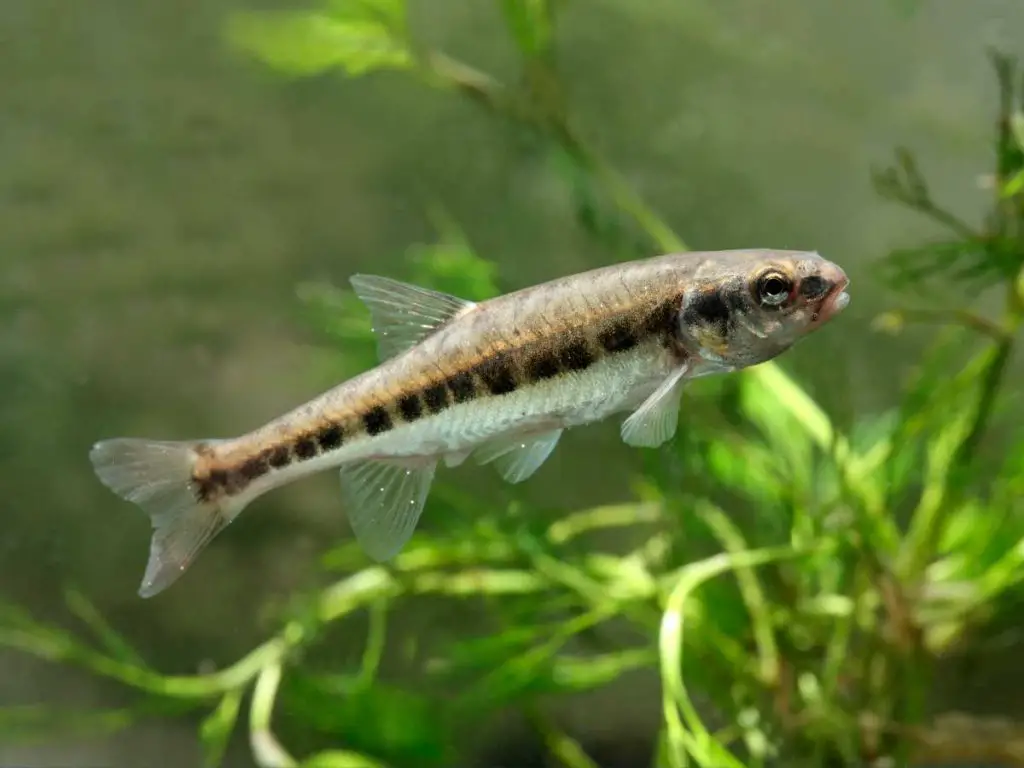
When considering any of these fish for a koi pond, always ensure the environment is suitable for their specific needs.
When considering adding any of these fish to a koi pond, it’s essential to do thorough research and ensure that the pond environment is suitable for them. Factors like pond size, water temperature, oxygen levels, and potential predators should be taken into account.
Reference table of fish sizes and temperaments
Now, it’s important to consider the size and temperament of these fish when planning your pond setup. You wouldn’t want to overcrowd your pond or accidentally introduce aggressive fish that could harm your koi.
| Fish Species | Maximum Size | Temperament | Pros of Keeping with Koi | Cons of Keeping with Koi |
|---|---|---|---|---|
| Goldfish | 10-12 inches | Peaceful | Compatible temperament; visually appealing | Potential competition for food |
| Comet Goldfish | 10-12 inches | Peaceful | Compatible temperament; visually appealing | Potential competition for food |
| Sarasa Comet | 10-12 inches | Peaceful | Compatible temperament; visually appealing | Potential competition for food |
| Shubunkin | 10-12 inches | Peaceful | Compatible temperament; visually appealing | Potential competition for food |
| Bitterling Fish | 2-3 inches | Peaceful | Small size; less competition for food | Risk of being eaten if koi are significantly larger |
| Golden Orfe | 16-20 inches | Peaceful | Compatible size and temperament with koi | Requires good oxygen levels |
| Minnows | 1-3 inches | Peaceful | Beneficial for insect control; small bioload | Risk of being eaten by larger koi |
| Grass Carp | Up to 4 feet | Peaceful | Algae control; compatible temperament with koi | Can grow very large; may disturb pond plants |
| Rosy Red Minnows | 2-3 inches | Peaceful | Hardy; beneficial for insect control | Risk of being eaten by larger koi |
| Sterlet Sturgeon | Up to 40 inches | Peaceful | Bottom feeders; can help in cleaning the pond bottom | Requires colder water; sensitive to medications |
Please note that while these fish can coexist with koi under the right conditions, individual experiences may vary based on the specific environment, pond size, and care provided. Always monitor new introductions to ensure compatibility and the well-being of all fish.
Remember, it’s also always a good idea to research and understand the specific needs and behavior of each fish species before introducing them to your pond. Creating a harmonious community of fish will not only provide an aesthetically pleasing environment but also ensure the well-being of all your aquatic friends.
Managing koi fish aggression
Creating a harmonious environment for your pond fish is essential for their well-being. While koi are generally peaceful, there can be instances of aggression, especially during feeding times or when there’s a mix of different fish species. To ensure that all your fish coexist peacefully, it’s crucial to take proactive measures. In this section, we’ll delve into strategies to manage and reduce aggression among your pond fish, ensuring a serene and safe habitat for all.
Providing ample hiding spaces
If you have a mix of fish in your pond, it’s important to create hiding spaces for them. This will give the smaller fish a chance to escape and take cover from any aggressive koi that may be causing trouble. Rocks, plants, and other structures can provide these safe hiding spots. Plus, they add some aesthetic appeal to your pond!
Separating aggressive koi from other fish
If you notice one particular koi getting a bit too aggressive with its tank mates, it may be necessary to temporarily remove them from the group. You can set up a separate tank or section within your pond where the aggressive koi can live on their own until they learn some manners.
Adjusting feeding routines to reduce aggression
Feeding time can be the prime opportunity for koi aggression to rear its ugly head. To minimize this, consider adjusting your feeding routines. Instead of feeding all the fish at once, try spreading out the food in different areas of the pond. This way, each fish can have their own space to eat peacefully, reducing the chances of aggressive behavior.
Feeding habits of koi fish
Koi fish are known for their voracious appetites and are considered opportunistic eaters. They actively search for food and will consume a wide variety of items that come their way.
Their primary diet consists of both plant matter and small aquatic creatures. They enjoy feasting on algae, duckweed, water insects, and crustaceans. Koi are also known to eat small fish if given the opportunity. So, it’s important to ensure they are getting a balanced diet to prevent them from seeking out other fish as a food source.
In addition to their natural feeding habits, supplemental feeding is commonly practiced to meet their nutritional needs. There are various options for supplementing their diet, including commercial koi pellets, flakes, and even homemade recipes. Some enthusiasts enjoy hand-feeding their koi treats like worms or shrimp for added interaction and pleasure.
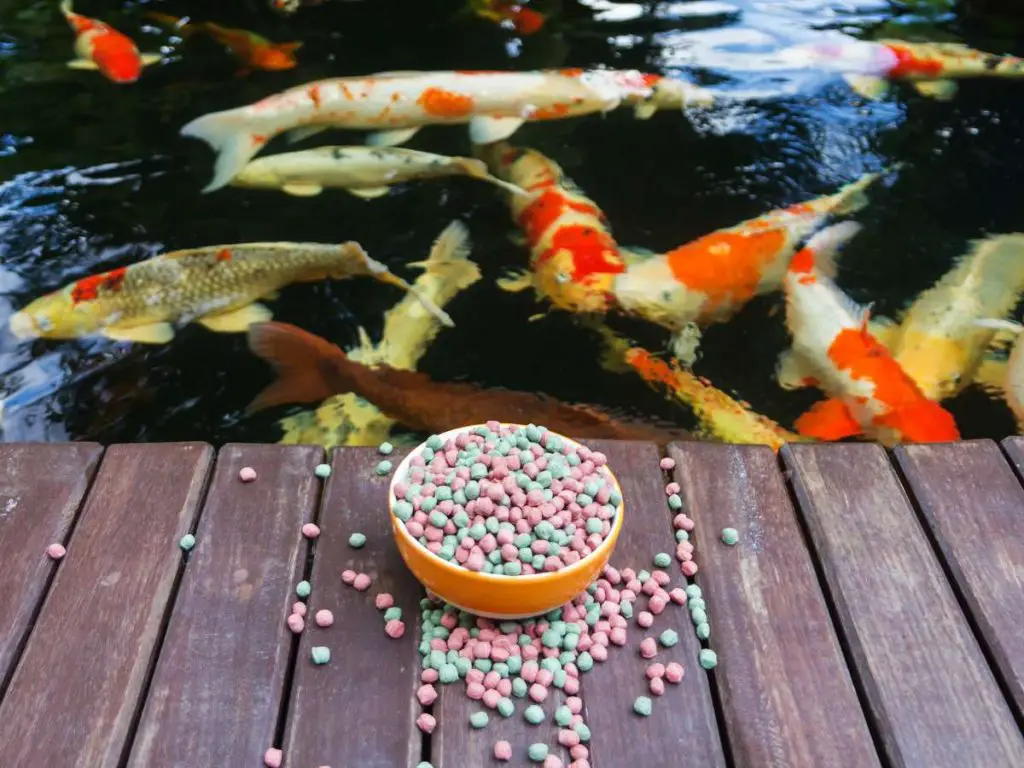
A balanced diet is crucial to maintain the health and vitality of koi fish. It’s important to provide them with a combination of protein, carbohydrates, fats, vitamins, and minerals. This can be achieved by offering a high-quality, nutritionally balanced koi food that meets their specific dietary requirements.
However, it’s important not to overfeed koi as this can lead to obesity and health problems. Feeding koi too much can also increase their aggressive tendencies, as they may become territorial over food. Therefore, it’s best to follow a feeding schedule and offer an appropriate amount of food that can be consumed within a few minutes.
To ensure that smaller fish are protected from potential predation by koi, it’s recommended to have separate feeding zones. This can be done by using floating feeding rings or nets to confine the koi while allowing the smaller fish to eat undisturbed. This strategy minimizes food competition and reduces the risk of aggression or accidental ingestion of other fish.
Protecting smaller fish from koi predators
Keeping smaller fish with koi can be a challenging task, as koi have a natural inclination to prey on smaller fish. However, with the right strategies and precautions, you can protect your smaller fish from becoming a koi’s next meal.
Options for creating separate fish zones
One effective way to protect smaller fish from koi predators is to create separate zones within your pond. This can be done by using aquatic plants, rocks, or other structures to create hiding spots where smaller fish can take refuge. By creating these distinct areas, you give smaller fish the opportunity to escape and find safety when they sense a koi’s predatory behavior.
Use of nets or barriers to prevent fish predation
Another option to consider is using nets or barriers to physically separate the koi from the smaller fish. This can be particularly useful if you have specific fish that are more vulnerable to predation. By placing a net or a barrier in the pond, you create a physical barrier that prevents the koi from reaching the smaller fish. However, it is important to regularly check and adjust the net or barrier to ensure that it remains effective.
Feeding strategies to minimize aggressive behavior
Feeding habits can play a significant role in reducing the predatory behavior of koi towards smaller fish. By providing ample food for the koi, you can help satisfy their natural instinct to hunt for food. This can help minimize their interest in preying on smaller fish. Additionally, you can consider using feeders that release food at different areas of the pond. This way, the smaller fish can have access to food without having to compete directly with the koi.
Keep Your Koi Safe, Sound, and Well Fed
If you are interested in keeping koi with other fish, it is important to choose the right fish species that are compatible in terms of size and temperament. Managing koi fish aggression can be achieved by providing ample hiding spaces, separating aggressive individuals, and adjusting feeding routines to reduce aggression.
It’s also crucial to consider the pond’s size, filtration system, and overall environment. While these fish can coexist, they all contribute to the bioload of the pond. Overstocking can lead to water quality issues and stress for the fish.
Ultimately, koi fish do eat other fish, and when keeping them with other species, it is important to consider compatibility, manage aggression, and ensure proper nutrition and protection for all the fish involved. Understanding koi fish behavior is key to successful fish keeping and maintaining a harmonious aquatic environment.
Key Takeaways:
- Koi fish are capable of eating other fish.
- Size compatibility, aggression levels, food competition, and space requirements are important factors to consider when keeping koi with other fish.
- Choosing compatible fish species and managing aggression can help maintain harmony in the pond.
- Providing a balanced diet is crucial for the overall well-being of koi fish.
- Creating separate fish zones, using nets and barriers, and implementing feeding strategies can protect smaller fish from koi predators.
Related Questions
Can koi fish live with goldfish?
Yes, koi fish can generally coexist with goldfish. Both species have similar care requirements and can thrive together in the same pond or tank, as long as there is ample space and proper filtration. However, it’s important to consider the size and aggression levels of individual koi and goldfish, as compatibility can vary.
What should I feed my koi fish?
Koi fish have an omnivorous diet, so they require a balanced mix of protein-based and plant-based foods. High-quality koi pellets or flakes can serve as the main staple, supplemented with fresh vegetables like lettuce, peas, and watermelon. It’s also beneficial to occasionally offer live or frozen foods like brine shrimp and bloodworms to mimic their natural feeding habits.

